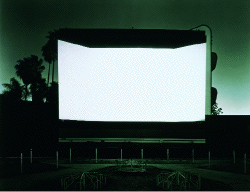American Standard
Barbara Gladstone Gallery, New York, USA
Barbara Gladstone Gallery, New York, USA

Recall a scene from Todd Haynes' 1995 film Safe. Carol, played by Julianne Moore, wakes in the dark in her spacious, hypoallergenic bedroom, her husband sleeping shapelessly next to her. She wanders downstairs and out into her well-trimmed yard, where she stands looking at the featureless suburb around her. Time slows to a crawl. 'American Standard: (Para) Normality and Everyday Life' centres on such ominous non-events; indeed the storyboards from Safe included in the show seem remarkably detached from that film's catastrophic narrative of nosebleeds, spasms and New Age sing-a-longs. Haynes' housewife looks impassively out of a car window or sits motionless in her bedroom while her husband snores.
Curator Gregory Crewdson has an eye for such static Surrealism, and it binds the works in 'American Standard' across media and histories. Robert Gober shares a room with Robert Adams and Richard Dreyfuss, manic and filthy in Close Encounters of the Third Kind (1977). Maureen Gallace's low-key Vermont Winter (2002) is next to Charles Ray's Pop-bright photo of a woman with her trousers stuffed with food (Before and After, 2001). The show's strength is in these counter-intuitive relays and imaginative connections: picture Gober's furry wax leg poking from the wood panel of Adams' generic Western home, Dreyfuss chewing his way through a scene from Safe. These careful juxtapositions point toward the subtle sense of dream logic and suspended animation evident in all the works on display.
Crewdson is no Surrealist, though, and if the imagery in this show is dreamlike, it is never as perverse or explosive as Surrealism proper - the still of the frothing Dreyfuss notwithstanding. Rather, it embodies Crewdson's idiosyncratic version of realism, one that is attuned to the strangeness of everyday life as it encounters the exaggerations of consumer culture, the phantasmagoria of Hollywood or the coercive ciphers of normality. For Crewdson this realism is, strangely, an effect of light: the glow of the TV screen, the luminous description of Edward Hopper or the otherworldly Photorealism of Robert Bechtle - or conversely, the fluorescent shadows of Eric Fischl or Tim Davis. This pervasive light both invokes and denaturalizes the effect of reality on offer in the images. In 'American Standard' every representation slowly begins to seem elaborately staged, cinematic, simultaneously unreal and hyperreal.
This theatricality is generally bound to specific, deeply invested sites: the suburban lawn, the drive-in cinema, the family living-room. Hiroshi Sugimoto's Compton Drive-In, Compton (1994), for instance, represents its site at night, aglow but strangely deserted, haunted by the now absent forms of social life that once inhabited it (peculiar though they were: spilt soda and fucking in the back seat). The show is full of such familiar places become surreal scenes: the motel pool in Eric Fischl's Best Western (1983), the distorted reflection on the screen door of Tim Davis' Shell 2, Kearny (2000), Carol's bedroom in Safe. In this exhibition these sites have all become malevolent or defensive, vacant or ghostly.
This sounds somewhat dour. But Crewdson shares with Haynes the ability to be serious and very funny in the same moment, and at its best 'American Standard' leavens its critique with camp. Fischl's Best Western - a boy bowling oranges at toy cowboys on the edge of a dark motel pool - resonates with vulgar-Freudian dread, but also with such superficial Surrealism that it can't help but be funny. Moreover, the work shares a corner with Keith Edmier's gawky polyvinyl girl (Jill Peters, 1997) and John Currin's hilarious portrait of Mary O'Connel (1989), creating a relay of creepy-funny associations between them: a discourse on play and pose, on childhood and, provocatively, on race. The 'standard' America represented here is invariably white, from Gober's pallid leg to Haynes' translucent housewife.
Currin's painting is the crux of this ensemble. It portrays a typical (read: white) teenage girl striking the instinctive screwface pose provoked by the unflattering yearbook photo. She looks as if she's under attack: her feathered hair is a helmet and her face has all the laconic, vulnerable hostility of an LA gangster. O'Connel's uptight pose matches that of Haynes' Carol: stiff, posed, uncomfortable, inarticulate, but unmistakably thwarted and resentful. Normality in these terms is constant, unpleasant work, and rarely successful.
There is perverse pleasure as well as pathos in 'American Standard'. It is present in the auto-eroticism of Fischl's boy and the unkempt ecstasy of Richard Dreyfuss' UFO-obsessed father in Close Encounters (1977). But this pleasure comes at a price, inevitably paid by the women. Dreyfuss leaves with the aliens, while his wife and kids conveniently disappear? Now that's unreal.





















